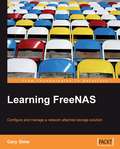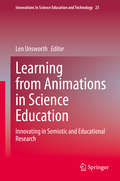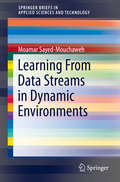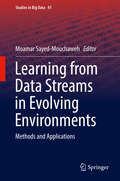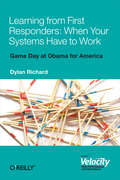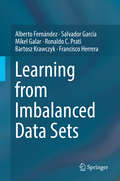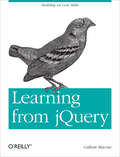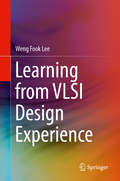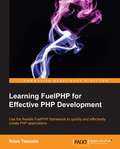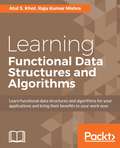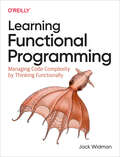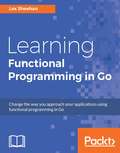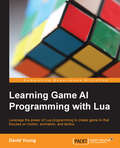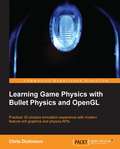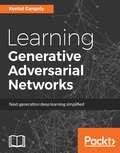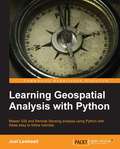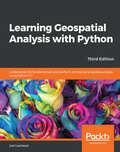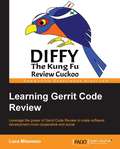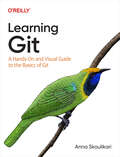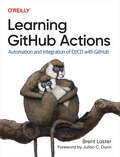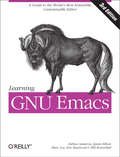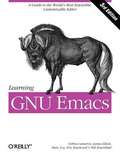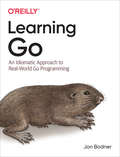- Table View
- List View
Learning FreeNAS
by Gary SimsThis book has been written from the system administrator's perspective, tackling the topics that will be most important to help you understand FreeNAS, and get it set up as securely and quickly as possible. You will just see how to get the job done. This book is for systems administrators who want a low cost, simple way to provide large amounts of network-attached storage. It does not assume knowledge of BSD, and will work for people using FreeNAS in any network environment.
Learning from Animations in Science Education: Innovating in Semiotic and Educational Research (Innovations in Science Education and Technology #25)
by Len UnsworthThis book examines educational semiotics and the representation of knowledge in school science. It discusses the strategic integration of animation in science education. It explores how learning through the creation of science animations takes place, as well as how animation can be used in assessing student’s science learning. Science education animations are ubiquitous in a variety of different online sites, including perhaps the most popularly accessed YouTube site, and are also routinely included as digital augmentations to science textbooks. They are popular with students and teachers and are a prominent feature of contemporary science teaching. The proliferation of various kinds of science animations and the ready accessibility of sophisticated resources for creating them have emphasized the importance of research into various areas: the nature of the semiotic construction of knowledge in the animation design, the development of critical interpretation of available animations, the strategic selection and use of animations to optimize student learning, student creation of science animations, and using animation in assessing student science learning. This book brings together new developments in these research agendas to further multidisciplinary perspectives on research to enhance the design and pedagogic use of animation in school science education. Chapter 1 is available open access under a Creative Commons Attribution 4.0 International License via link.springer.com.
Learning from Data Streams in Dynamic Environments
by Moamar Sayed-MouchawehThis book addresses the problems of modeling, prediction, classification, data understanding and processing in non-stationary and unpredictable environments. It presents major and well-known methods and approaches for the design of systems able to learn and to fully adapt its structure and to adjust its parameters according to the changes in their environments. Also presents the problem of learning in non-stationary environments, its interests, its applications and challenges and studies the complementarities and the links between the different methods and techniques of learning in evolving and non-stationary environments.
Learning from Data Streams in Evolving Environments: Methods And Applications (Studies in Big Data #41)
by Moamar Sayed-MouchawehThis edited book covers recent advances of techniques, methods and tools treating the problem of learning from data streams generated by evolving non-stationary processes. The goal is to discuss and overview the advanced techniques, methods and tools that are dedicated to manage, exploit and interpret data streams in non-stationary environments. The book includes the required notions, definitions, and background to understand the problem of learning from data streams in non-stationary environments and synthesizes the state-of-the-art in the domain, discussing advanced aspects and concepts and presenting open problems and future challenges in this field. Provides multiple examples to facilitate the understanding data streams in non-stationary environments;Presents several application cases to show how the methods solve different real world problems;Discusses the links between methods to help stimulate new research and application directions.
Learning from First Responders: When Your Systems Have to Work
by Dylan RichardOne of the side stories of the 2012 presidential campaign was the success of Obama's software team. The team built their software in-house, and put into practice many ideas from the DevOps world. Game day was one of the most important: an exercise in which part of the team tried as hard as possible to break their systems, while the rest of the team tried to keep things running. They simulated everything from database failure to massive network outages. And as a result, when the election came, they were certain that they could respond to any crisis.
Learning from Imbalanced Data Sets
by Alberto Fernández Salvador García Mikel Galar Ronaldo C. Prati Bartosz Krawczyk Francisco HerreraThis book provides a general and comprehensible overview of imbalanced learning. It contains a formal description of a problem, and focuses on its main features, and the most relevant proposed solutions. Additionally, it considers the different scenarios in Data Science for which the imbalanced classification can create a real challenge. This book stresses the gap with standard classification tasks by reviewing the case studies and ad-hoc performance metrics that are applied in this area. It also covers the different approaches that have been traditionally applied to address the binary skewed class distribution. Specifically, it reviews cost-sensitive learning, data-level preprocessing methods and algorithm-level solutions, taking also into account those ensemble-learning solutions that embed any of the former alternatives. Furthermore, it focuses on the extension of the problem for multi-class problems, where the former classical methods are no longer to be applied in a straightforward way.This book also focuses on the data intrinsic characteristics that are the main causes which, added to the uneven class distribution, truly hinders the performance of classification algorithms in this scenario. Then, some notes on data reduction are provided in order to understand the advantages related to the use of this type of approaches.Finally this book introduces some novel areas of study that are gathering a deeper attention on the imbalanced data issue. Specifically, it considers the classification of data streams, non-classical classification problems, and the scalability related to Big Data. Examples of software libraries and modules to address imbalanced classification are provided.This book is highly suitable for technical professionals, senior undergraduate and graduate students in the areas of data science, computer science and engineering. It will also be useful for scientists and researchers to gain insight on the current developments in this area of study, as well as future research directions.
Learning from jQuery: Building on Core Skills
by Callum MacraeIf you're comfortable with jQuery but a bit shaky with JavaScript, this concise guide will help you expand your knowledge of the language--especially the code that jQuery covers up for you. Many jQuery devotees write as little code as possible, but with some JavaScript under your belt, you can prevent errors, reduce overhead, and make your application code more efficient.This book explores event handling, prototypes, and working with the DOM and AJAX through examples and lots of code. You'll learn common conventions and patterns in JavaScript and--if you've never coded with JavaScript before--a tutorial will take you through the basics.Enhance your jQuery code by using object constructors and prototypesReduce overhead and gain more control by handling events with JavaScriptWork with the DOM much faster with JavaScript than you can with jQuerySend a few AJAX requests without having to load the entire jQuery libraryUnderstand the importance of JavaScript code standards, comments, code reuse, and anti-patternsEnlist JavaScript resources, such as a good IDE, a syntax checker, and version control
Learning from VLSI Design Experience
by Weng Fook LeeThis book shares with readers practical design knowledge gained from the author’s 24 years of IC design experience. The author addresses issues and challenges faced commonly by IC designers, along with solutions and workarounds. Guidelines are described for tackling issues such as clock domain crossing, using lockup latch to cross clock domains during scan shift, implementation of scan chains across power domain, optimization methods to improve timing, how standard cell libraries can aid in synthesis optimization, BKM (best known method) for RTL coding, test compression, memory BIST, usage of signed Verilog for design requiring +ve and -ve calculations, state machine, code coverage and much more. Numerous figures and examples are provided to aid the reader in understanding the issues and their workarounds.
Learning FuelPHP for Effective PHP Development
by Ross TweedieThe book follows a standard tutorial approach, which will enable readers to use the FuelPHP framework efficiently while developing PHP applications.If you are a PHP developer who is looking to learn more about using the FuelPHP framework for effective PHP development, this book is ideal for you. If you are interested in this book, you should already have a basic understanding of general PHP development.
Learning Functional Data Structures and Algorithms
by Raju Kumar Mishra Atul S. KhotLearn functional data structures and algorithms for your applications and bring their benefits to your work now About This Book • Moving from object-oriented programming to functional programming? This book will help you get started with functional programming. • Easy-to-understand explanations of practical topics will help you get started with functional data structures. • Illustrative diagrams to explain the algorithms in detail. • Get hands-on practice of Scala to get the most out of functional programming. Who This Book Is For This book is for those who have some experience in functional programming languages. The data structures in this book are primarily written in Scala, however implementing the algorithms in other functional languages should be straight forward. What You Will Learn • Learn to think in the functional paradigm • Understand common data structures and the associated algorithms, as well as the context in which they are commonly used • Take a look at the runtime and space complexities with the O notation • See how ADTs are implemented in a functional setting • Explore the basic theme of immutability and persistent data structures • Find out how the internal algorithms are redesigned to exploit structural sharing, so that the persistent data structures perform well, avoiding needless copying. • Get to know functional features like lazy evaluation and recursion used to implement efficient algorithms • Gain Scala best practices and idioms In Detail Functional data structures have the power to improve the codebase of an application and improve efficiency. With the advent of functional programming and with powerful functional languages such as Scala, Clojure and Elixir becoming part of important enterprise applications, functional data structures have gained an important place in the developer toolkit. Immutability is a cornerstone of functional programming. Immutable and persistent data structures are thread safe by definition and hence very appealing for writing robust concurrent programs. How do we express traditional algorithms in functional setting? Won't we end up copying too much? Do we trade performance for versioned data structures? This book attempts to answer these questions by looking at functional implementations of traditional algorithms. It begins with a refresher and consolidation of what functional programming is all about. Next, you'll get to know about Lists, the work horse data type for most functional languages. We show what structural sharing means and how it helps to make immutable data structures efficient and practical. Scala is the primary implementation languages for most of the examples. At times, we also present Clojure snippets to illustrate the underlying fundamental theme. While writing code, we use ADTs (abstract data types). Stacks, Queues, Trees and Graphs are all familiar ADTs. You will see how these ADTs are implemented in a functional setting. We look at implementation techniques like amortization and lazy evaluation to ensure efficiency. By the end of the book, you will be able to write efficient functional data structures and algorithms for your applications. Style and approach Step-by-step topics will help you get started with functional programming. Learn by doing with hands-on code snippets that give you practical experience of the subject.
Learning Functional Programming: Managing Code Complexity By Thinking Functionally
by Jack WidmanLearn how to think and write code like a functional programmer. With this practical guide, software developers familiar with object-oriented programming will dive into the core concepts of functional programming and learn how to use both functional and OOP features together on large or complex software projects.Author Jack Widman uses samples from Java, Python, C#, Scala, and JavaScript to help you gain a new perspective and a set of tools for managing the complexity in your problem domain. You'll be able to write code that's simpler, reusable, easier to test and modify, and more consistently correct. This book also shows you how to use patterns from category theory to help bridge the gap between OOP and functional programming.Learn functional programming fundamentals and explore the way functional programmers approach problemsUnderstand how FP differs from object-oriented and imperative programmingUse a set of practical, applicable design patterns that model reality in a functional wayLearn how to incorporate FP and OOP features into software projectsApply functional design patterns appropriately and use them to write correct, robust, and easily modifiable code
Learning Functional Programming in Go
by Lex SheehanFunction literals, Monads, Lazy evaluation, Currying, and more About This Book • Write concise and maintainable code with streams and high-order functions • Understand the benefits of currying your Golang functions • Learn the most effective design patterns for functional programming and learn when to apply each of them • Build distributed MapReduce solutions using Go Who This Book Is For This book is for Golang developers comfortable with OOP and interested in learning how to apply the functional paradigm to create robust and testable apps. Prior programming experience with Go would be helpful, but not mandatory. What You Will Learn • Learn how to compose reliable applications using high-order functions • Explore techniques to eliminate side-effects using FP techniques such as currying • Use first-class functions to implement pure functions • Understand how to implement a lambda expression in Go • Compose a working application using the decorator pattern • Create faster programs using lazy evaluation • Use Go concurrency constructs to compose a functionality pipeline • Understand category theory and what it has to do with FP In Detail Functional programming is a popular programming paradigm that is used to simplify many tasks and will help you write flexible and succinct code. It allows you to decompose your programs into smaller, highly reusable components, without applying conceptual restraints on how the software should be modularized. This book bridges the language gap for Golang developers by showing you how to create and consume functional constructs in Golang. The book is divided into four modules. The first module explains the functional style of programming; pure functional programming (FP), manipulating collections, and using high-order functions. In the second module, you will learn design patterns that you can use to build FP-style applications. In the next module, you will learn FP techniques that you can use to improve your API signatures, to increase performance, and to build better Cloud-native applications. The last module delves into the underpinnings of FP with an introduction to category theory for software developers to give you a real understanding of what pure functional programming is all about, along with applicable code examples. By the end of the book, you will be adept at building applications the functional way. Style and approach This book takes a pragmatic approach and shows you techniques to write better functional constructs in Golang. We'll also show you how use these concepts to build robust and testable apps.
Learning Game AI Programming with Lua
by David YoungIf you are a game developer or a general programmer who wishes to focus on programming systems and techniques to build your game AI without creating low-level interfaces in a game engine, then this book is for you. Knowledge of C++ will come in handy to debug the entirety of the AI sandbox and expand on the features present within the book, but it is not required.
Learning Game Physics with Bullet Physics and OpenGL
by Chris DickinsonA comprehensive set of straight-forward, easy-to-follow tutorials in OpenGL and Bullet Physics that will teach you how modern game physics and 3D graphics work.If you're a beginner or intermediate programmer with a basic understanding of 3D mathematics, and you want a stronger foundation in 3D graphics and physics, then this book is perfect for you! You'll even learn some of the fundamental concepts in 3D mathematics and software design that lies beneath them both, discovering some techniques and tricks in graphics and physics that you can use in any game development project.
Learning Generative Adversarial Networks
by Kuntal GangulyBuild image generation and semi-supervised models using Generative Adversarial Networks About This Book • Understand the buzz surrounding Generative Adversarial Networks and how they work, in the simplest manner possible • Develop generative models for a variety of real-world use-cases and deploy them to production • Contains intuitive examples and real-world cases to put the theoretical concepts explained in this book to practical use Who This Book Is For Data scientists and machine learning practitioners who wish to understand the fundamentals of generative models will find this book useful. Those who wish to implement Generative Adversarial Networks and their variant architectures through real-world examples will also benefit from this book. No prior knowledge of generative models or GANs is expected. What You Will Learn • Understand the basics of deep learning and the difference between discriminative and generative models • Generate images and build semi-supervised models using Generative Adversarial Networks (GANs) with real-world datasets • Tune GAN models by addressing the challenges such as mode collapse, training instability using mini batch, feature matching, and the boundary equilibrium technique. • Use stacking with Deep Learning architectures to run and generate images from text. • Couple multiple Generative models to discover relationships across various domains • Explore the real-world steps to deploy deep models in production In Detail Generative models are gaining a lot of popularity among the data scientists, mainly because they facilitate the building of AI systems that consume raw data from a source and automatically builds an understanding of it. Unlike supervised learning methods, generative models do not require labeling of the data which makes it an interesting system to use. This book will help you to build and analyze the deep learning models and apply them to real-world problems. This book will help readers develop intelligent and creative application from a wide variety of datasets, mainly focusing on visuals or images. The book begins with the basics of generative models, as you get to know the theory behind Generative Adversarial Networks and its building blocks. This book will show you how you can overcome the problem of text to image synthesis with GANs, using libraries like Tensorflow, Keras and PyTorch. Transfering style from one domain to another becomes a headache when working with huge data sets. The author, using real-world examples, will show how you can overcome this. You will understand and train Generative Adversarial Networks and use them in a production environment and learn tips to use them effectively and accurately. Style and approach A step-by-step guide that will teach you the use of appropriate GAN models for image generation, editing and painting, text-to-image synthesis, image style transfer, and cross-domain discovery with Python libraries such as Tensorflow, Keras, and PyTorch.
Learning Geospatial Analysis with Python
by Joel LawheadThis is a tutorial-style book that helps you to perform Geospatial and GIS analysis with Python and its tools/libraries. This book will first introduce various Python-related tools/packages in the initial chapters before moving towards practical usage, examples, and implementation in specialized kinds of Geospatial data analysis.This book is for anyone who wants to understand digital mapping and analysis and who uses Python or another scripting language for automation or crunching data manually.This book primarily targets Python developers, researchers, and analysts who want to perform Geospatial, modeling, and GIS analysis with Python.
Learning Geospatial Analysis with Python: Understand GIS fundamentals and perform remote sensing data analysis using Python 3.7, 3rd Edition
by Joel LawheadLearn the core concepts of geospatial data analysis for building actionable and insightful GIS applications Key Features Create GIS solutions using the new features introduced in Python 3.7 Explore a range of GIS tools and libraries such as PostGIS, QGIS, and PROJ Learn to automate geospatial analysis workflows using Python and Jupyter Book Description Geospatial analysis is used in almost every domain you can think of, including defense, farming, and even medicine. With this systematic guide, you'll get started with geographic information system (GIS) and remote sensing analysis using the latest features in Python. This book will take you through GIS techniques, geodatabases, geospatial raster data, and much more using the latest built-in tools and libraries in Python 3.7. You'll learn everything you need to know about using software packages or APIs and generic algorithms that can be used for different situations. Furthermore, you'll learn how to apply simple Python GIS geospatial processes to a variety of problems, and work with remote sensing data. By the end of the book, you'll be able to build a generic corporate system, which can be implemented in any organization to manage customer support requests and field support personnel. What you will learn Automate geospatial analysis workflows using Python Code the simplest possible GIS in just 60 lines of Python Create thematic maps with Python tools such as PyShp, OGR, and the Python Imaging Library Understand the different formats that geospatial data comes in Produce elevation contours using Python tools Create flood inundation models Apply geospatial analysis to real-time data tracking and storm chasing Who this book is for This book is for Python developers, researchers, or analysts who want to perform geospatial modeling and GIS analysis with Python. Basic knowledge of digital mapping and analysis using Python or other scripting languages will be helpful.
Learning Gerrit Code Review
by Luca MilanesioA practical and a fast paced guide that gives you all the information you need to make software development more cooperative and social. This book is written for team leaders and developers who wish to reap the benefit of Gerrit and improve collaboration by introducing code review practices.
Learning Git: A Hands-on And Visual Guide To The Basics Of Git
by Anna SkoulikariThis book teaches Git in a simple, visual, and tangible manner so that you can build a solid mental model of how Git version control works. Through the use of color, storytelling, and hands-on exercises, you will learn to use this tool with confidence.The information is introduced incrementally so that you don't get bogged down with unknown terms or concepts. Learning Git is ideal for anyone who needs to use Git for personal or professional projects: coding bootcamp students, junior developers, data professionals, and technical writers, to name just a few!This book covers how to:Download Git and initialize a local repositoryAdd files to the staging area and make commitsCreate, switch, and delete branchesMerge and rebase branchesWork with remote repositories including cloning, pushing, pulling, and fetchingUse pull requests to collaborate with others
Learning GitHub Actions
by Brent LasterAutomate your software development processes with GitHub Actions, the continuous integration and continuous delivery platform that integrates seamlessly with GitHub. With this practical book, open source author, trainer, and DevOps director Brent Laster explains everything you need to know about using and getting value from GitHub Actions. You'll learn what actions and workflows are and how they can be used, created, and incorporated into your processes to simplify, standardize, and automate your work in GitHub.This book explains the platform, components, use cases, implementation, and integration points of actions, so you can leverage them to provide the functionality and features needed in today's complex pipelines and software development processes. You'll learn how to design and implement automated workflows that respond to common events like pushes, pull requests, and review updates. You'll understand how to use the components of the GitHub Actions platform to gain maximum automation and benefit.With this book, you will:Learn what GitHub Actions are, the various use cases for them, and how to incorporate them into your processesUnderstand GitHub Actions' structure, syntax, and semanticsAutomate processes and implement functionalityCreate your own custom actions with Docker, JavaScript, or shell approachesTroubleshoot and debug workflows that use actionsCombine actions with GitHub APIs and other integration optionsIdentify ways to securely implement workflows with GitHub ActionsUnderstand how GitHub Actions compares to other options
Learning GNU Emacs: A Guide to Unix Text Processing
by James Elliott Debra Cameron Bill Rosenblatt Eric S. Raymond Marc LoyGNU Emacs is the most popular and widespread of the Emacs family of editors. It is also the most powerful and flexible. Unlike all other text editors, GNU Emacs is a complete working environment--you can stay within Emacs all day without leaving. Learning GNU Emacs, 3rd Edition tells readers how to get started with the GNU Emacs editor. It is a thorough guide that will also "grow" with you: as you become more proficient, this book will help you learn how to use Emacs more effectively. It takes you from basic Emacs usage (simple text editing) to moderately complicated customization and programming. The third edition of Learning GNU Emacs describes Emacs 21.3 from the ground up, including new user interface features such as an icon-based toolbar and an interactive interface to Emacs customization. A new chapter details how to install and run Emacs on Mac OS X, Windows, and Linux, including tips for using Emacs effectively on those platforms. Learning GNU Emacs, third edition, covers: How to edit files with Emacs Using the operating system shell through Emacs How to use multiple buffers, windows, and frames Customizing Emacs interactively and through startup files Writing macros to circumvent repetitious tasks Emacs as a programming environment for Java, C++, and Perl, among others Using Emacs as an integrated development environment (IDE) Integrating Emacs with CVS, Subversion and other change control systems for projects with multiple developers Writing HTML, XHTML, and XML with Emacs The basics of Emacs Lisp The book is aimed at new Emacs users, whether or not they are programmers. Also useful for readers switching from other Emacs implementations to GNU Emacs.
Learning GNU Emacs, 2nd Edition
by Debra Cameron Eric S. Raymond Bill RosenblattThis comprehensive guide to the GNU Emacs editor, one of the most widely used and powerful editors available under UNIX, covers basic editing, several important "editing modes" (special Emacs features for editing specific types of documents, including email, Usenet News, and the Web), and customization and Emacs LISP programming. It is aimed at new Emacs users, whether or not they are programmers. Covers Version 19.30.
Learning GNU Emacs, 3rd Edition
by Debra Cameron James Elliott Marc LoyThe third edition of Learning GNU Emacs describes Emacs 21.3 from the ground up, including new user interface features such as an icon-based toolbar and an interactive interface to Emacs customization. A new chapter details how to install and run Emacs on Mac OS X, Windows, and Linux, including tips for using Emacs effectively on those platforms.
Learning GNU Emacs, 3rd Edition
by Debra Cameron James Elliott Marc Loy Eric S. Raymond Bill RosenblattThe third edition of Learning GNU Emacs describes Emacs 21.3 from the ground up, including new user interface features such as an icon-based toolbar and an interactive interface to Emacs customization. A new chapter details how to install and run Emacs on Mac OS X, Windows, and Linux, including tips for using Emacs effectively on those platforms.
Learning Go: An Idiomatic Approach To Real-world Go Programming
by Jon BodnerGo is rapidly becoming the preferred language for building web services. While there are plenty of tutorials available that teach Go's syntax to developers with experience in other programming languages, tutorials aren't enough. They don't teach Go's idioms, so developers end up recreating patterns that don't make sense in a Go context. This practical guide provides the essential background you need to write clear and idiomatic Go.No matter your level of experience, you'll learn how to think like a Go developer. Author Jon Bodner introduces the design patterns experienced Go developers have adopted and explores the rationale for using them. You'll also get a preview of Go's upcoming generics support and how it fits into the language.Learn how to write idiomatic code in Go and design a Go projectUnderstand the reasons for the design decisions in GoSet up a Go development environment for a solo developer or teamLearn how and when to use reflection, unsafe, and cgoDiscover how Go's features allow the language to run efficientlyKnow which Go features you should use sparingly or not at all
